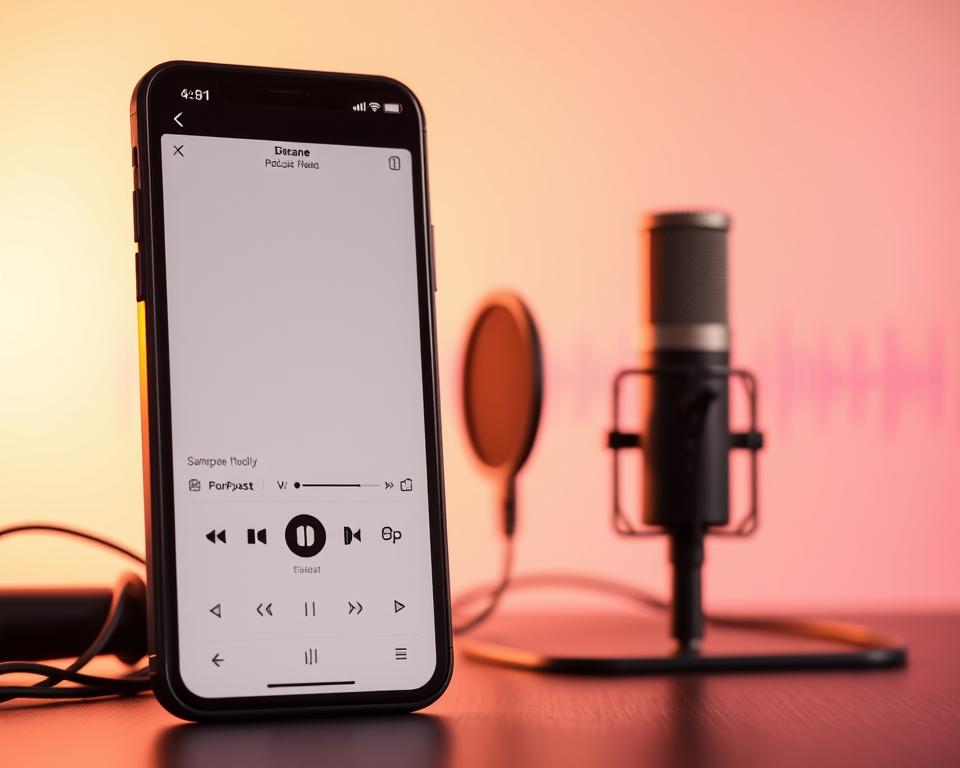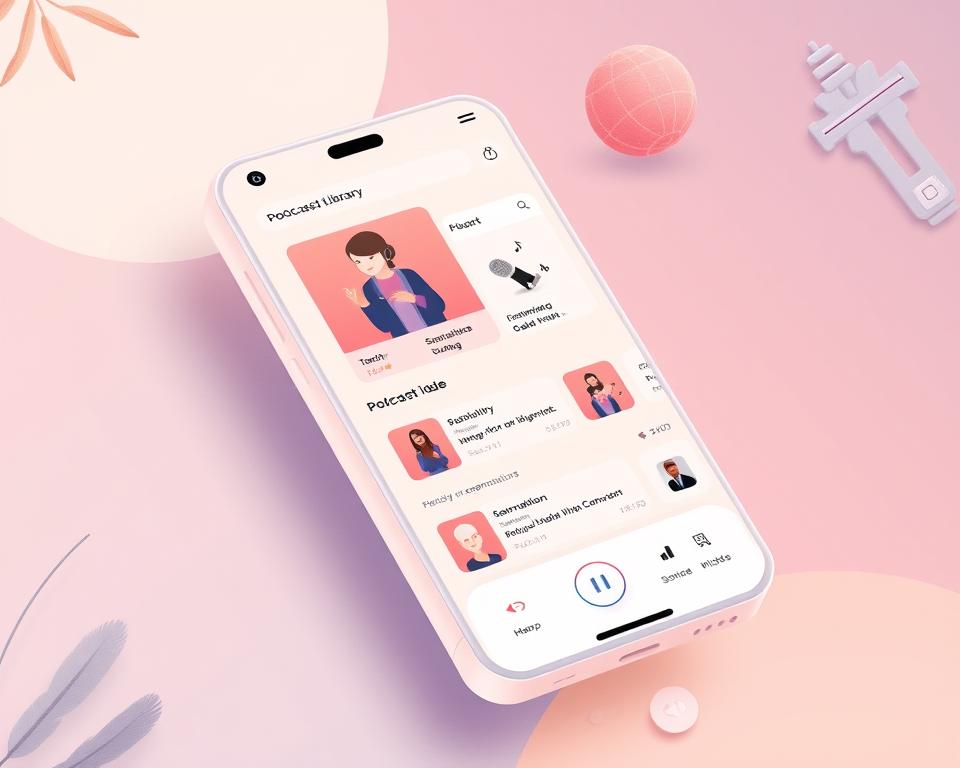Podcasting has grown a lot, making it key to have a good podcast app. Apple Podcasts is a top example. It’s all about making an app that lets users find, download, and listen to podcasts easily. A well-made app like Apple Podcasts is vital for a great user experience.
To make a podcast app like Apple Podcasts, you need to think about important features, technical stuff, and how to make money. Knowing what makes a good podcast app helps developers create something great. A well-made app can keep users interested, make money, and build a strong brand in the podcast world.
Table of Contents
Introduction to Podcast App Development
Getting the basics of podcast app development right is key. You need a user-friendly design, core functions, and smooth audio streaming. By focusing on these, you can make an app that rivals Apple Podcasts and meets listener needs.
Key Takeaways
- Creating a podcast app like Apple Podcasts means thinking about important features and technical needs.
- A good app design is crucial for a smooth user experience.
- Knowing what makes a successful podcast app can boost user engagement and revenue.
- Designing an app that’s easy to use and has core functions is important.
- Smooth audio streaming is a must for a great podcast app.
- Developers should aim to create an app that meets listener needs.
- Podcast app development is about making an app that lets users find, download, and listen to podcasts easily.
Understanding the Podcast App Market Landscape
The podcast market is booming, with millions tuning in globally. To make a hit podcast app, knowing the market size and growth is key. Big names like Apple, Spotify, and Google lead the way, offering a vast array of podcasts.
Understanding who listens to podcasts is crucial. Age, location, and listening habits shape the app’s design. For example, age affects what content appeals to users. The audience for podcast apps is wide-ranging, with different tastes and habits.
The players in the podcast app market keep changing. New ones pop up, and old ones grow. Knowing the market well is essential for a successful app. By studying the market size, key players, and audience, developers can make an app that shines.
Several things shape how people listen to podcasts:
- Content variety
- User experience
- Discovery features
By focusing on these, developers can craft an app that resonates with its audience. This way, they can stay competitive in the podcast world.
Essential Features of a Successful Podcast App
A top podcast app needs a user-friendly interface for easy navigation and finding new shows. The podcast app features should include search, playlists, and social sharing. These features improve the user’s experience. Some key features to think about are:
- Personalized recommendations to help users discover new podcasts
- Easy-to-use search functionality to find specific podcasts or episodes
- Playlists to organize and save favorite episodes or podcasts
- Social sharing to allow users to share their favorite podcasts with friends and family
For discovery, a good podcast app should make it simple to find new content. It can have features like:
A well-designed user interface is also key for a successful podcast app. The interface should be intuitive and easy to use. It should have clear navigation and minimal clutter. By adding these essential features, a podcast app can offer a smooth and enjoyable experience. This makes it more likely to attract and keep users.
Technical Requirements for Podcast App Development
Creating a podcast app like Apple Podcasts needs a lot of planning. You must think about the backend, frontend tools, and how to stream audio smoothly. These details are key to making the app work well, grow, and feel good to use.
The backend infrastructure must be strong and grow with your app. You’ll need to pick the right programming languages, databases, and caching. Using cloud services like AWS or GCP can help with growth and reliability.
For the frontend development, tools like React Native or Flutter are great. They help make the app look good and work well. Using these tools also means you can add cool features like episode lists and player controls. Plus, following best practices can make your app run smoothly and catch fewer bugs.
Some important things to think about include:
- Backend infrastructure needs, such as server-side programming languages and database management systems
- Frontend development tools, such as React Native or Flutter
- API integration requirements for seamless audio streaming
- Database management systems, such as MySQL or MongoDB
By planning well and executing these steps, developers can make a top-notch podcast app. This app will offer a great experience for podcast fans.
How to Develop a Podcast App Like Apple Podcasts: Step-by-Step Approach
Creating a podcast app like Apple Podcasts needs a deep understanding of the podcast app development process. To make a successful app, it’s key to follow a step-by-step guide. This guide covers planning, design, development, and testing phases.
A good plan for podcast app development includes several important steps. These are:
- Defining the app’s purpose and target audience
- Designing a user-friendly interface
- Developing a robust backend infrastructure
- Implementing essential features, such as audio streaming and user management
- Testing and iterating on the app to ensure a seamless user experience
By following this step-by-step guide, developers can make a high-quality podcast app. It’s also crucial to keep up with the latest trends and best practices in podcast app development. This helps the app stay competitive in the market.
The secret to successful podcast app development is to focus on creating a user-centric app. This means making an app that offers a seamless and engaging experience for listeners. By putting user needs first and following a structured development approach, developers can make a standout podcast app in a crowded market.
Designing the User Interface
A good user interface is key for a podcast app. It affects how users feel when they use it. Think about how easy it is to navigate, organize content, and use visual elements. A clean design helps users find and explore new podcasts easily.
A simple navigation makes it easy to look through different podcast types. This makes the app more enjoyable to use.
The user interface should be smooth and easy to use. It should let users quickly find important features. Content organization is important here. It keeps things tidy and makes the app easier to use.
- Simple and consistent navigation
- Easy access to key features and functions
- Logical and consistent content organization
- Visual elements that enhance the user experience
By focusing on these points, you can make a user interface that works well and looks good. This will make your users happy.
Core Functionality Implementation
The core of a podcast app is all about giving users a smooth listening experience. This means audio streaming and playback work well. Developers must think about things like buffering, caching, and how to handle errors.
To make a great podcast app, focus on a smooth listening experience. This means making core functionality work well on all devices and platforms.
Here are some important things to consider when building your app:
- Buffering and caching to keep the flow going
- Error handling for a seamless experience
- Optimizing playback for all devices and platforms
By paying attention to these details, you can make a podcast app that users will love. It will have core functionality that meets their needs.
Audio Streaming and Management Systems
Efficient audio streaming is key for a smooth podcast app experience. Understanding streaming protocols and content delivery networks (CDNs) is essential. These systems ensure audio is delivered securely and reliably.
Content delivery networks (CDNs) are vital for less latency and a better listening experience. They cache audio at various locations, making podcasts faster to access. This leads to a more enjoyable user experience. Important aspects of audio streaming and management include:
- Streaming protocols: HTTP, HTTPS, and other protocols that enable secure audio delivery
- Content delivery networks (CDNs): Akamai, Cloudflare, and other CDNs that facilitate efficient audio streaming
- Caching mechanisms: techniques used to reduce latency and improve audio delivery, such as caching audio content at multiple locations
By using effective audio streaming and management systems, podcast apps can offer a top-notch listening experience. This boosts user engagement and satisfaction.
| Streaming Protocol | Content Delivery Network | Caching Mechanism |
|---|---|---|
| HTTP | Akamai | Cache audio content at multiple locations |
| HTTPS | Cloudflare | Use caching headers to reduce latency |
User Management and Authentication
Effective user management is key for a podcast app. It lets users get personalized recommendations and subscribe easily. A strong authentication system is vital to keep user data safe and stop unauthorized access. This means using things like password hashing and salting to protect accounts.
A good user management system makes it simple for users to set up and manage their accounts. They can update their profiles and change passwords without hassle. This is thanks to a user-friendly interface that’s easy to use.
Some important features of a user management system include:
- Registration and login functionality
- Profile management and editing
- Password recovery and reset
- Account deletion and deactivation
By having a solid user management and authentication system, podcast apps can offer a safe and personalized experience. This is crucial for building trust and loyalty with users. It also helps the app stay competitive in the market.
Security is also a big deal in podcast app development. It’s about stopping data breaches, protecting user privacy, and following the law. By focusing on security and authentication, developers can make a safe space for users to enjoy their podcasts.
Content Discovery and Recommendation Engine
A good content discovery system is key for a podcast app. It helps listeners find new and interesting content. This is done through a recommendation engine that suggests podcasts based on what users like.
The engine uses machine learning to get better at suggesting podcasts. It learns from how users behave and changes its suggestions over time.
Creating a recommendation engine involves a few important steps. These include:
- Data collection: gathering user data, such as listening history and ratings
- Algorithm development: creating algorithms that analyze user data and generate recommendations
- Machine learning integration: incorporating machine learning techniques to improve the accuracy of recommendations
By using machine learning and a strong recommendation engine, a podcast app can offer a personalized experience. This makes users more engaged and loyal. It also helps the app grow and make more money.
| Feature | Description |
|---|---|
| Personalization | Provides users with tailored recommendations based on their listening history and preferences |
| Discovery | Enables users to discover new podcasts and episodes through a content discovery system |
| Machine Learning | Integrates machine learning techniques to improve the accuracy of recommendations |
Monetization Strategies and Implementation
Creating a podcast app like Apple Podcasts needs a good plan for making money. One way is to add advertising to the app. This lets creators earn from their shows. They can use banner ads, audio ads, or sponsored content.
Getting sponsorships from brands is another smart move. It brings in steady money. Also, affiliate marketing can help by promoting products in the podcast’s area, earning a commission for each sale.
Some top ways to make money include:
- Dynamic ad insertion
- Podcast sponsorships
- Affiliate marketing
- Subscription-based models
It’s key to think about how users feel when adding ads or sponsored content. The goal is to keep the app user-friendly and engaging. This way, developers can build a profitable and lasting business.
Testing and Quality Assurance
Keeping a podcast app stable and secure is key to its success. This is where testing and quality assurance play a big role. Quality assurance involves a series of tests to check if the app works well, performs as expected, and is safe.
Testing is a vital part of quality assurance. It includes performance testing to see how fast and reliable the app is. This helps find problems and improve the app, making it smooth for users.
- Performance testing to evaluate the app’s speed and scalability
- User acceptance testing to validate the app’s functionality and usability
- Security testing to identify vulnerabilities and protect user data
By using these testing methods during development, developers can make sure their podcast app is top-notch. This ensures users have a great experience and helps the app stand out in a crowded market.
| Testing Method | Description |
|---|---|
| Performance Testing | Evaluates the app’s speed, scalability, and reliability |
| User Acceptance Testing | Validates the app’s functionality and usability |
| Security Testing | Identifies vulnerabilities and protects user data |
App Store Optimization and Launch Strategy
Launching a podcast app needs a solid plan. This includes app store optimization to boost visibility and downloads. A good plan also involves marketing to reach the right people.
To succeed, focus on app store optimization tips like keyword use and icon design. A catchy icon can really grab attention. Also, a detailed launch strategy should cover pre-launch prep, post-launch checks, and ongoing marketing.
For a successful launch, consider these points:
- Do market research to know your audience
- Find a unique selling point to stand out
- Build excitement with social media and influencer help
A smart launch strategy can greatly impact a podcast app’s success. By using app store optimization and marketing, developers can get more visibility, downloads, and reach their goals.
| Launch Strategy | App Store Optimization | Marketing |
|---|---|---|
| Pre-launch preparation | Keyword optimization | Social media promotion |
| Post-launch evaluation | Icon design | Influencer partnerships |
Maintenance and Updates
Regular maintenance is key for a podcast app’s stability and security. It means keeping an eye on user feedback and analytics. This helps developers know what to improve first.
They focus on updates and bug fixing to make the app better. This makes the app more enjoyable for users.
Important parts of maintenance and updates are:
- Watching user feedback for trends and patterns
- Looking at analytics to plan future updates
- Fixing bugs to make the app smooth for users
- Adding new features to keep up with the competition
By regularly updating and maintaining, developers keep their app stable and fun. This leads to happier users and more positive reviews.
Good maintenance also means keeping current with new trends and practices. This keeps the app safe and follows the rules, protecting user data.
Legal Considerations and Compliance
When making a podcast app, it’s key to think about legal considerations to stay safe. You need to get the right licenses and permissions for any copyrighted stuff. Also, make sure you follow terms of service and copyright laws. Not doing this can lead to big problems, like lawsuits and losing money.
Another important thing is data protection. With more worries about user data, it’s vital to protect it well. You must follow rules like GDPR and CCPA, which are strict about how to handle user data.
Some important steps to follow legal considerations and stay compliant include:
- Get the right licenses and permissions for copyrighted content
- Use strong data protection measures
- Follow copyright laws and rules
By focusing on legal considerations and following the rules, developers can make their podcast app launch go smoothly. They also protect their users’ rights and interests.
| Regulation | Description |
|---|---|
| GDPR | General Data Protection Regulation, a European Union regulation on data protection |
| CCPA | California Consumer Privacy Act, a California state law on data protection |
| Copyright Laws | Laws that protect intellectual property rights, including copyrights and trademarks |
Conclusion
Creating a podcast app like Apple Podcasts needs careful planning and upkeep. Looking ahead, it’s key to keep up with the latest trends and innovations. For tips on making a successful podcast, check out how to create a podcast and learn from the pros.
The podcasting world is growing fast, opening new doors for developers and creators. Knowing the key features, technical needs, and ways to make money is crucial. This way, developers can make top-notch apps that users will love. In short, the future of podcast app development is full of promise.
As we go forward in podcast app development, staying current is vital. This ensures apps stay competitive and offer the best user experience. With the right strategy and deep knowledge of the field, the possibilities are endless. We can look forward to many new and exciting podcast apps in the future.



















